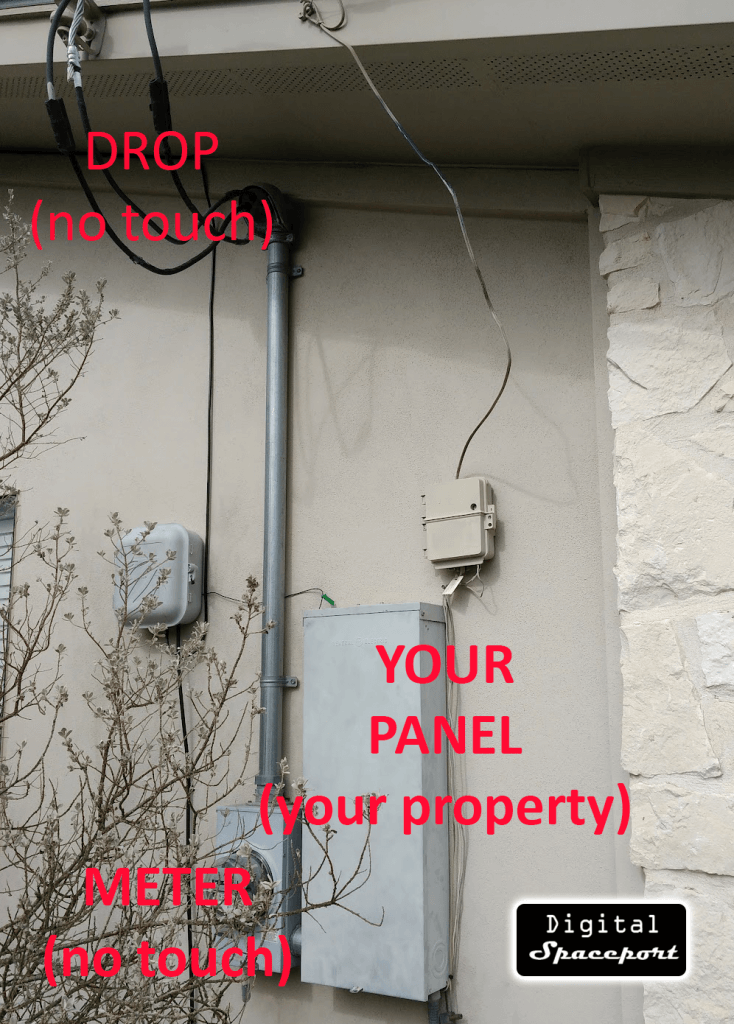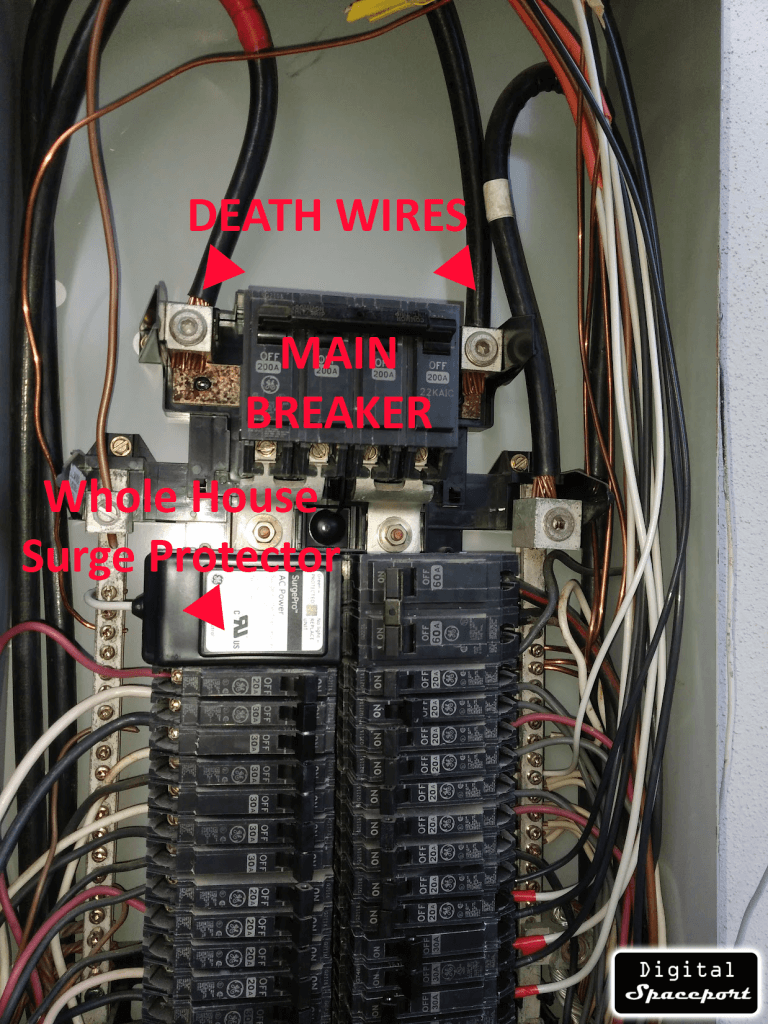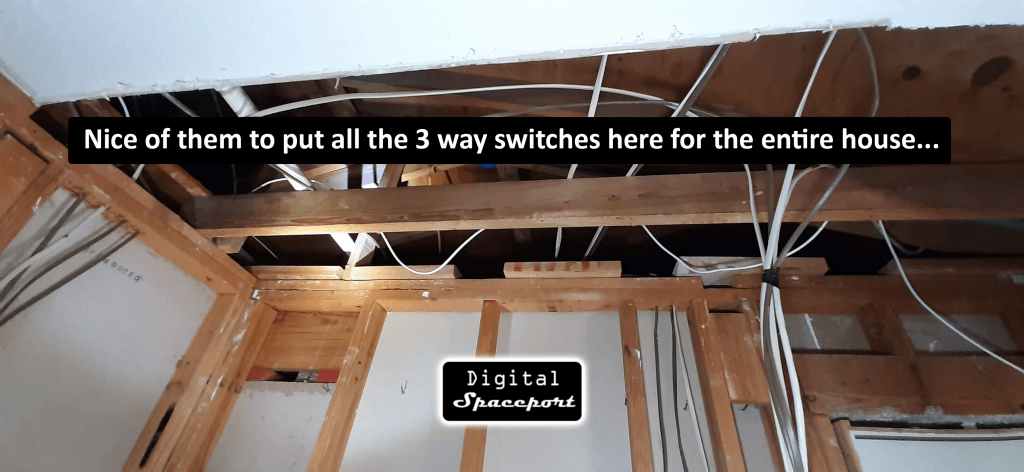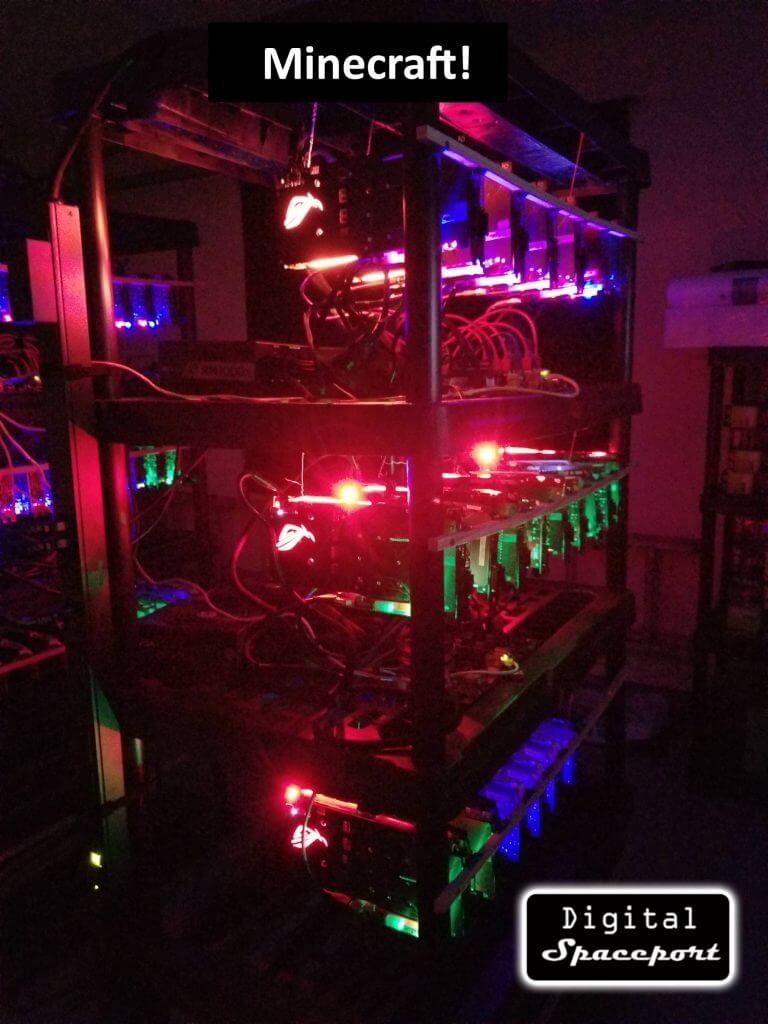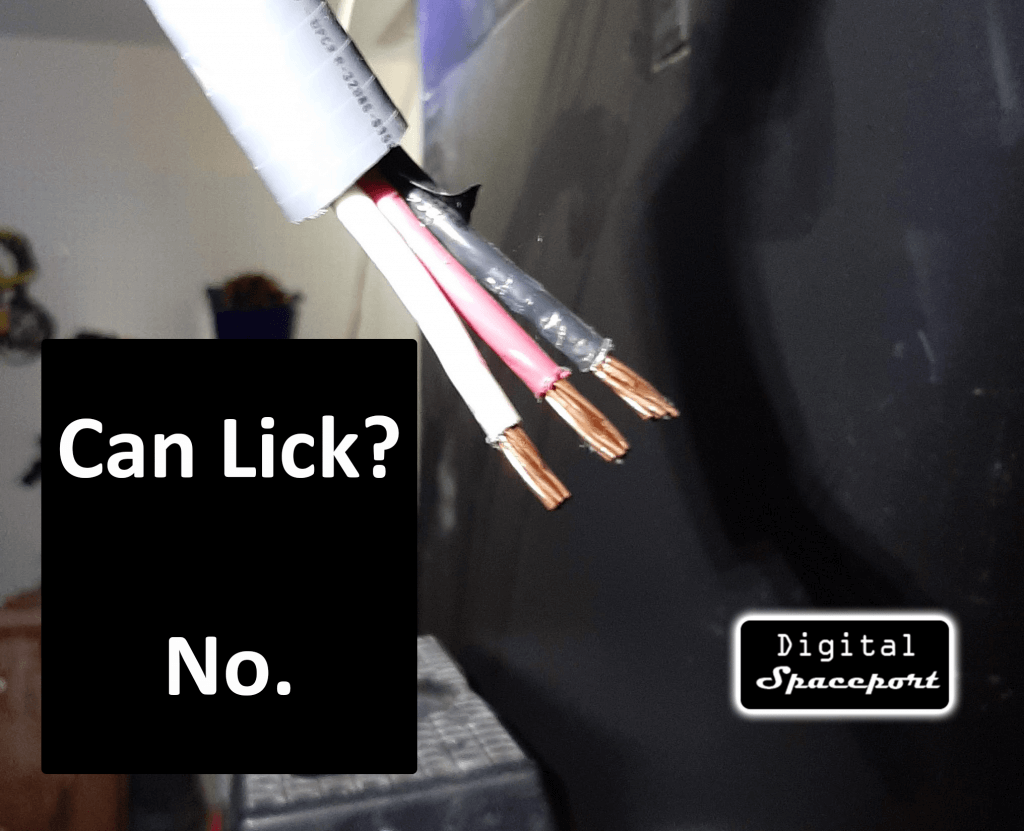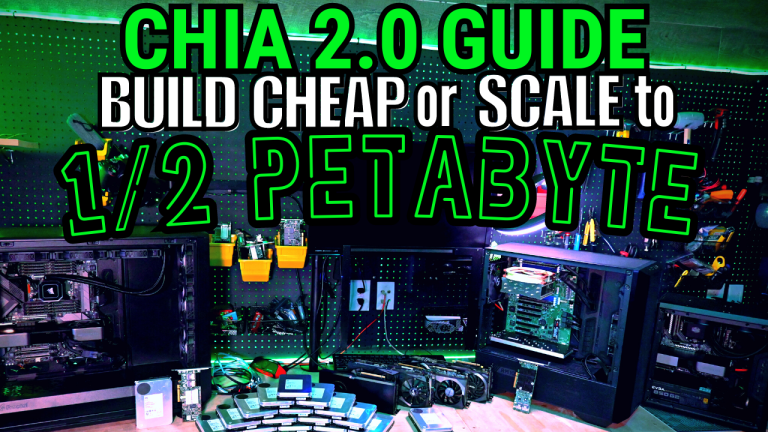Home Data Center/Mining Rig/Server Room Electrical Guide:
A quick guide on electrical and safety of operating high voltage systems. I felt I would do a write-up here but READ first…
- IF YOU DIE/KILL SOMEONE ELSE, INJURE YOURSELF OR SOMEONE ELSE, BURN DOWN YOUR HOUSE, OR BLOW UP….IT’S ON YOU. I ASSUME NO RESPONSIBILITY. YOU SHOULD ALWAYS CONTACT AN ELECTRICIAN!
Electrical Load Basics for Home Servers
We need the juice, and lots of it! It seems that we can never get enough good wattage to the machines to run that extra last card. So here is how you start knowing what is going on in your house and electrical as well as stay safe and sound. Let’s start at the outside of the house.
The Drop
This is a few, typically 3, large heavy twisted wires that are either coming down from a pole to your roofline or up from the ground if you have underground utilities. These should NEVER be touched nor messed with. They are not your property and anything that happens to them you are liable for, and the electric company WILL come after you for damages. They will supply a total of around 220-240 volts.
Side note: you can call the electrical company to trim any dangerously overhanging trees that are near these power lines. This is free and a good idea while we are at this.
The Meter
Yup again this is not your “property” so don’t mess with it unless you want a very large bill. Look up at the head of it. Does it have 2 black wires and 1 silver wire? Then you have single phase service. Does it have 3 black and a silver? That’s 3-phase. Not many homes will have 3-phase. The rest of this is ONLY applicable to single phase service.
The Disconnect
This is sometimes present. Sometimes it is just the amps breakers used for this purpose. If it is present, it is a fat copper plate that will be inline prior to the circuit box. (It may have a lockhole on it. Do you have yours locked? Not a bad idea.)
The Mains
Basically, the circuit panel is the first part of the electrical system that you own and that is your property. This wonderful box controls your ability to eat the electric you need. It is sometimes outside a house, sometimes inside a house. It is always live to some degree unless the electric company has pulled the meter.
The main circuits are going to very likely be 200 amps into you house. It might be 2 large fat black double breakers or a long single arm breaker. Unless you asked for an additional 200 amps from the power company, it’s 200 amps. That disconnects the entire house. You should NEVER work on a panel yourself unless you KNOW what you are doing.
Tossing that main breaker does kill power to the rest of the panel. It does not mean you cannot still get electrocuted if you open the panel. You can/will get shocked if you go on the other side of the 200-amp breakers (DEATH WIRES, see picture) THEY ARE ALWAYS HOT. The meter does not disconnect when you flip the mains breaker. The wires leading up to the breaker (DEATH WIRES, see picture) are always live unless you are standing next to the electric company and an electrician who have pulled your meter.
Now you will see your individual breakers. These will be labeled 15 or 20 amp (on the breaker) and a few 30, 40 50, 60-amp ones also (stove, hot tub, washer/dryer, …server room UPS?) Most modern homes are wired for 20 amps to the plugs, and 15 amps to the lights. NEVER mess around with your lights’ wiring trying to get servers or rigs on it.
Many older homes are 15 amps. There are some important reasons to note the age of our home. For example, wire colors have changed over the years several times.
It is now the perfect time to clean up the crappy label job the installer electrician did. Using masking tape and a sharpie, go tape over the sides and write in which plugs are affected. Use room and a number starting with 1-X. Then mark the outlets if you suspect a room is on 2 circuits (i.e. the outlet in the house gets a label bathroom/master/1….the circuit breaker gets a label bathroom/master). That happens in bathroom sharing walls often.
You won’t leave the label on the house outlet (unless you are really OCD), but you will use it to create a nice map of your house and breakers. This should come standard with every house. I have never heard of it coming with any house.
Now that we know the amps and what each breaker controls, let’s move inside for a bit.
What Gauge Wires?
This is important. For lighting it’s often 14 AWG; for outlets it’s usually 12 AWG. The bigger the wire (12 gauge is larger than 14 just FYI, it will present less resistance [heat] as electrons vibrate along it). You will especially need to know your wire size to the plugs/area you are wiring if you have an old house!
Make sure you have the breaker to the plugs you are wiring turned off/tossed off. Heck, toss the 200-amp breaker to be safe. Better yet, CALL AN ELECTRICIAN. This is especially important if you are going to take a receptacle (plug) plate cover off and take a measurement of that wire.
Or you like crawling in the attic because you like living on the edge! Then try finding the wires in the way it was done below!
You can usually see, if you crawl in the attic, a huge bundle of yellow/white wires (newer homes) or brown/white wires (older homes) running all over the place. Those are your house’s romex wires. It should have the gauge printed/imprinted on it. If you see nothing but 14 AWG on the wires….beware. Call an electrician no matter what to confirm what you found. It will be the best 75 bucks you can spend.
The house may be underwired to the receptacles. This actually happened a lot in the past. If you see nothing but 12 AWG, that’s overkill but fine also. If you see both 12 and 14, you are like 90% of modern houses. It’s a decent assumption the 12 is running to the plugs and 14 to the lights.
Your Server’s Location
Find the Room(s) and outlet(s) that you want to have your server(s) on. Note them on a photocopy of our overhead map. Write out the WATTS TOTAL your servers will draw.
Calculating the Wattage that Plug Can Handle
Let’s say we know that we will be using about 620 watts at the wall. So that’s also on 120 volts since I am in the US. If you are in some other location, it may well be 220-230 volts.
How much draw can I get from this plug? Here is how we calculate that. So I have 120 Volts and 20 Amps. That is TOTAL 2400 watts of supply. Now I won’t draw over 80% of that, or if I do, I will pop the circuit most likely every time I go over 80% for a few moments.
Now let’s de-rate that. 2400 * 0.8 = 1920 Watts draw max.
If you have a spike above it briefly, it’s not a huge issue. This is often a breaker tossing problem, not a fire risk (unless you are in an older house, have 14-gauge wires, or some other mysterious configuration that supplies your electricity…in which case call an electrician).
So, we have 1920 watts. Let’s look at all the other things that are on that outlet. Add them up. Make sure to never have a window AC or printer/fax/shredder/microwave/bathroom/kitchen on the same circuit.
If you are smart you won’t run anything else off that circuit so you can get the full 1920. If you are not smart you may end up with a popped breaker (assuming it operates when it needs to, they are not a device to remove your negligence…they do fail…), a melted receptacle in the best case, and a house fire and death of all your loved ones in the worst-case scenario.
1920/620 = 3.1 So we could put 3.1 servers on that circuit. …It’s like I must have planned that out, right? 😉 So we will stick 3 servers on that puppy!
Nothing else needs to nor should run on that entire circuit, including other plugs that are on that circuit.
Q&A / FAQ / Pointers
Q. Can I “upgrade” to a 20-amp breaker on a 15-amp slot?
A. No, unless you want to burn down your house while you sleep and kill your family and pets. The answer is more complex than that, however, and you should contact a licensed electrician to tell you yes or no. Also have the 20-amp breaker that matches your other breakers already bought so that you can have him install it without some insane part charge while he is out. (GE breaker for GE panel, squareD for squareD…) It will come down to wire gauge and distance.
Q. Can I “upgrade” to a 30-amp breaker on a 20- or 15-amp slot?
A. No, unless death, third degree burns and skin grafts and a life of guilt for killing your loved ones sound like fun to you. This one is very much in the CALL ELECTRICIAN category. Don’t risk it as you 99% of the time don’t have large enough wires for the distance. Wire heat -> fire -> death.
Q. Can I get a new 200-amp service or upgraded 320 service installed on my house, for my garage?
A. Actually, probably yes. You might tell the power company you have some heavy machine tools to put in your garage. Call several electricians to get quotes.
Q. Does this all apply to 3 phase service?
A. Not a bit. You need to contact an electrician. Why do you have 3-phase service???
Q. Can I install a 30-amp breaker with a 220 VAC breakdown? Is that going to work to power my servers?
A. Yes, but you should have an electrician do all that. Think about the home insurance policy. It doesn’t cover your bad wire job and death also sucks.
Q. Will it be more efficient to run 220 VAC than 120 VAC?
A. Yes. See 1 above as that is your next question 🙂
Common Tables
-120 VAC, 30 Amp circuit = 2880 watts usable
-220 VAC, 30 Amp circuit = 5280 watts usable
-120 VAC, 20 Amp circuit = 1920 watts usable
-220 VAC, 20 Amp circuit = 3520 watts usable
-120 VAC, 15 Amp circuit = 1440 watts usable
-220 VAC, 15 Amp circuit = 2640 watts usable
Again, DO NOT “UPGRADE” YOUR BREAKERS. IT DOESN’T WORK LIKE THAT. You need new outlets, covers, receptacles, and code compliant stuff in about all cases.
Mine and Serve On!

